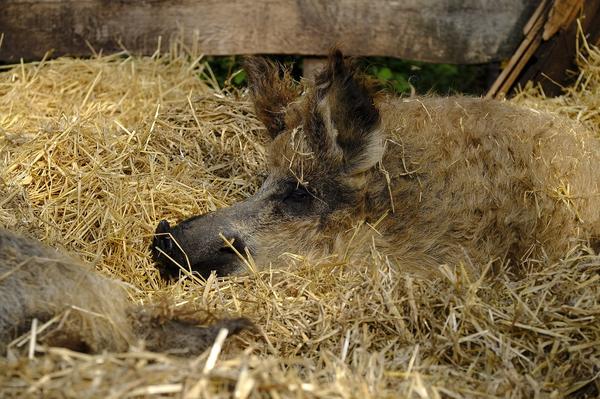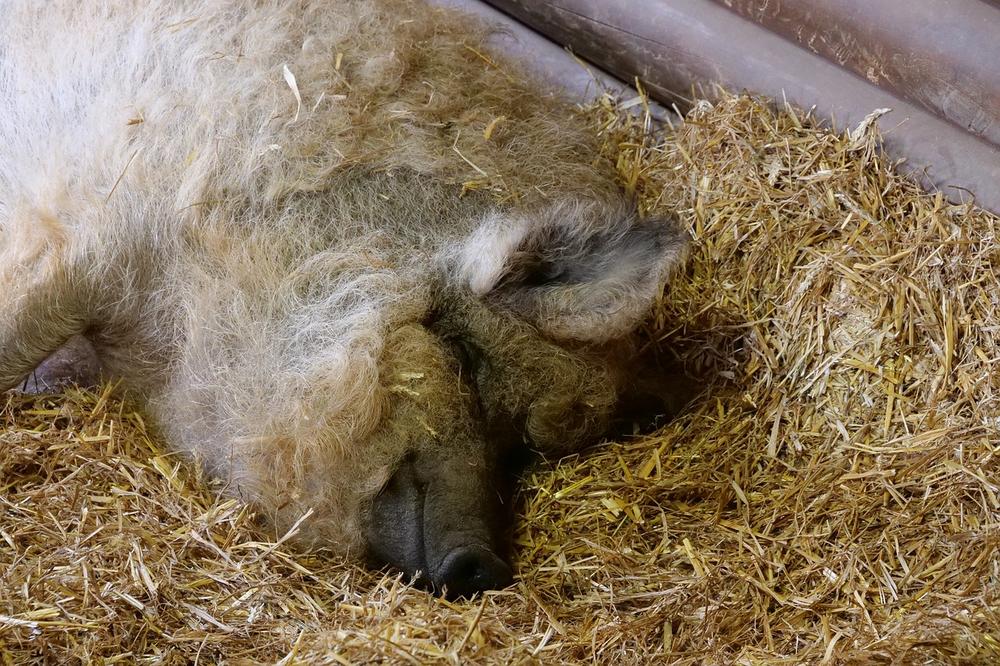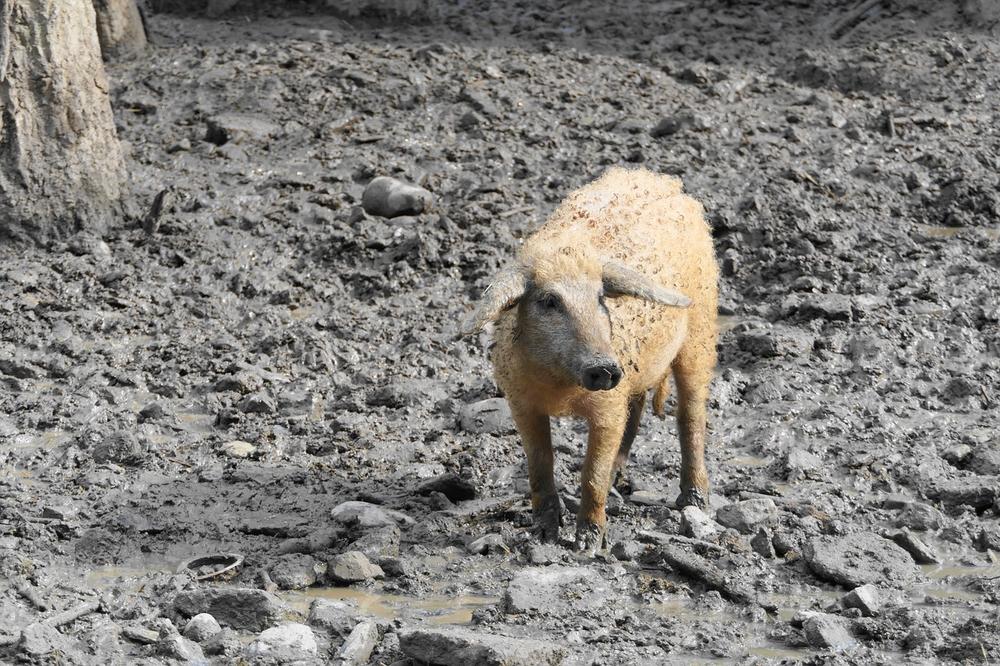What Is a Mangalica Pig: All About Their Heritage & History

Visualize this:
You stumble upon a peculiar animal, a creature that looks as if it stepped right out of a storybook.
It's rare, it's fascinating, and it's a mystery waiting to be unraveled 😮.
Curiosity consumes you, and you can't help but wonder, "What on earth is a mangalica pig?"
Well, my friend, let's satisfy that burning desire for knowledge together.
Let's dive deep into the heritage and characteristics of this enigmatic breed.
Are you ready for the journey ahead?
Then let's begin.
The Importance of Mangalica Pigs' Heritage
The preservation of Mangalica pigs' heritage was crucial as their popularity declined due to the decreasing demand for lard. However, the discovery of the exceptional taste of Mangalica pork led to a surge in demand, saving over 50,000 of these unique pigs annually.
The Mangalica pig breed is a big deal in Hungarian history and culture.
These woolly pigs, also known as sheep pigs, have a unique background that sets them apart from other pig breeds.
But here's the real kicker:
Preservation through consumption was key to saving these pigs.
When people no longer wanted lard, the popularity and existence of these domestic pigs were at stake.
However, things took a turn when folks realized how incredibly tasty Mangalica pork is.
I mean, seriously, this pig breed produces meat that is unmatched in flavor and tenderness.
Each bite is like a piece of heaven, thanks to the marbling in their meat.
It's pure succulence.
And get this:
Because of this newfound appreciation for Mangalica pork, more than 50,000 of these incredible pigs are saved from disappearing every year.
Pretty mind-blowing, right?
But enough about saving pigs.

Let's talk about what you really care about – the characteristics of Mangalica pigs and how they affect your taste buds.
These pigs have adorable curly or wavy hair that resembles sheep.
No wonder they're called sheep pigs!
To add to their charm, they even have long, curly eyelashes.
In terms of size, they can be pretty hefty, weighing anywhere from 200-400 pounds.
Their solid build is one reason why they were so valued for producing lard in the past.
Now I know what you're thinking.
You want to try some Mangalica pork ASAP, am I right?
Well, who could blame you?!
Here's the exciting part: You don't have to travel all the way to Hungary to get a taste of this magical pork. There are farms worldwide that breed these fantastic pigs, and you can find their delectable products in select gourmet stores or online.
So, next time you're planning a special meal, consider treating yourself to the extraordinary taste of Mangalica pork.
I promise you, your taste buds will shower you with gratitude.
Main points I'll expand upon further down this article:
- Mangalica pigs faced extinction in the 1990s due to declining popularity.
- The Hungarian Steppe climate protects Mangalica pigs with their unique fleecy coat.
- Mangalica pigs have a high fat content, making them one of the fattiest pigs.
- The lard from Mangalica pigs has a lower melting point due to its higher unsaturated fat content.
- The curly coat of Mangalica pigs distinguishes them from other pigs.
- Mangalica pigs come in variations of blonde, red, and swallow-bellied.
- Mangalica pork is known for its tasty lean meat and high omega-3 fatty acids.
- Traditional Mangalica sausage with sweet paprika is popular in Hungarian markets.
- Mangalica pigs grow slower and produce fewer piglets than lean breeds.
- Some specialized farmers in the United States continue to raise Mangalica pigs.
And here's the reality...
Despite its exceptional taste and cultural significance, the future of the Mangalica pig breed was far from secure.
Let me explain why this extraordinary breed faced such dire circumstances during the 1990s:
The History of Mangalica Pigs
The rare and cherished Mangalica pig breed suffered the risk of dying out in the 90s.
This happened because farming changed, favoring mass production over heritage breeds like the Mangalica.

Not only did their popularity dwindle, but the intensiveness of modern agriculture also didn't suit them. Mass production took center stage, leaving behind the Mangalica breed, which was ill-suited for such practices.
Consequently, their numbers diminished, and they faced the threat of vanishing completely.
It's a sad tale of neglect, where tradition clashed with the demands of an evolving industry.
Unique Characteristics of Mangalica Pigs
The Mangalica pig, my friend, is truly a one-of-a-kind creature.
Let me tell you about some of its unique characteristics:
- Its curly and fleecy coat is unlike anything you've ever seen on a pig. This coat comes in different colors like blonde, red, and swallowbellied - no other pig has such a fabulous fashion sense!
- This pig loves the cold weather. Originating from the Hungarian Steppe, it's built to handle even the harshest of climates with its cozy fleecy coat.
- Now, when it comes to fat content, this pig takes the crown. It boasts a whopping fat percentage ranging from 65% to 70%. Talk about being on the heavy side!
- What sets its lard apart from the rest is its lower melting point. You can thank the higher unsaturated fat content for that. But remember, my friend, moderation is key!
- Surprise, surprise! Despite their small size, these pigs share a close genetic relationship with wild boars. Nature never ceases to amaze us, does it?
- Lastly, let me tell you about their appetites. These pigs have an uncontrollable hunger. When they're eating, there's no blade of grass left untouched. They really take the saying "eat like a pig" to heart.
But wait, there's more to discover about the magnificent Mangalica pig breed!
Its unique characteristics are just the beginning.
So, let me intrigue you further with the tantalizing details about the remarkable taste and culinary applications of Mangalica pork.
Get ready to embark on a mouthwatering journey into the world of this extraordinary breed.
The Unique Culinary Applications and Exceptional Qualities of Mangalica Pork
Mangalica pork: A healthier choice with exceptional qualities
So, when it comes to pork, you might think that leaner is always better. But let me tell you, there's something special about Mangalica pork.
It's not your average pig meat.
First of all, Mangalica pork is known for its delicious taste.
And I'm not just talking about any old flavor.
This pork has a unique combination of rich and savory notes that will leave your taste buds begging for more.
Once you try it, regular pork won't cut it anymore.
But that's not all.
One of the reasons why Mangalica pork stands out is because it's packed with omega-3 fatty acids and natural antioxidants.
These are essential nutrients that are good for your health.
So, it's not only a treat for your taste buds, but also a boost for your body.
The culinary applications of Mangalica pork
Now that we know how amazing Mangalica pork is, let's talk about how you can enjoy it in your kitchen.
One popular way to savor this delicious pork is by turning it into sausage or salami.
The high fat content in Mangalica allows for longer drying periods without losing moisture, resulting in a flavorful and succulent end product.
Just imagine sinking your teeth into a juicy slice of Mangalica salami - it's a culinary experience like no other.
But wait, there's more.
In Spain, Mangalica pork takes on a whole new level of awesomeness.
It is used for air-cured processes, leading to the creation of renowned hams.
These hams have a moist texture, rich color, and complex flavor that can only come from aging the meat for up to 3½ years.
Yes, you read that right.
Three and a half years.
Now, that's dedication.
The rising popularity of Mangalica pork
Sure, Mangalica pork might be a bit pricier than other options, but trust me, it's worth every penny.
And guess what?
Discerning individuals in the United States are catching on to its exceptional qualities.
If you're a foodie craving something unique and extraordinary, keep an eye out for fresh and cured Mangalica products in the culinary scene.
Once you taste the difference, you'll understand why this special pork is gaining so much attention.
Don't miss your chance to experience the mouthwatering flavors and healthier benefits of Mangalica.
And if you're interested in delving deeper into the world of mangalica pork, I have just the resource for you.
Check out my article, the Ultimate Mangalica Pigs Handbook.
Breeding and Rearing Mangalica Pigs
Breeding and rearing Mangalica pigs can be a rewarding venture, despite their slower growth and lower piglet production.
Here are some important points to consider:
- Gestation period: Mangalica pigs have a gestation period of 3 months, 3 weeks, and 3 days. This means you need to plan ahead for their care and feeding during this time.
- Feeding: Providing a combination of foraged food, fresh vegetables, and nutritious pig pellets ensures that these pigs get the right nutrients for healthy development.
- Unique flavor and quality: The slower growth and reduced piglet production contribute to the unique flavor and exceptional quality of the meat from Mangalica pigs. It's worth noting that this breed is prized by culinary enthusiasts for its marbling and taste.
- Cooperative protection: Thanks to a program implemented in the early 1990s, cooperatives were established to protect and maintain the population of Mangalica pigs. Today, specialized farmers in the United States continue to raise them, preserving this rare breed.
And that's all for today folks.
If you wish to read more of my useful articles, I recommend you check out some of these: Large White Pigs Complete Guide, Berkshire Pigs Complete Guide, Can You Take Pigs for a Walk, Do Pet Pigs Cause Damage, and When Do Pigs Stop Growing
Until next time,
-Chris Campbell